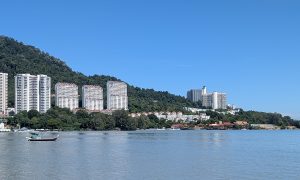Super Typhoon Ragasa, the strongest storm of 2025, tore through the Philippines, Taiwan, Hong Kong, Macau, and southern China with hurricane-force winds, catastrophic flooding, and the collapse of a barrier lake. Millions were evacuated, lives were lost, and the climate alarm grew louder than ever.
Nearly two million people in southern China were evacuated as Typhoon Ragasa made landfall, unleashing destructive winds, storm surges, and torrential rainfall. The storm, previously classified as a Category 5 super typhoon, had already devastated the Philippines and Taiwan before striking some of Asia’s most densely populated coastlines.

TAIWAN’S BARRIER LAKE BURSTS
In Taiwan’s eastern Hualien County, a natural dam gave way under Ragasa’s heavy rainfall, unleashing nearly 70 million tonnes of water into Guangfu township. The barrier lake had formed in July after a landslide blocked a river, creating a vast but unstable reservoir. Officials had monitored the site but determined draining was not feasible.
When the dam collapsed, torrents of water swept through Guangfu, inundating homes, destroying bridges, and carrying cars away. At least 17 people were confirmed dead, with more than a dozen still missing. The remote terrain and unstable slopes complicated rescue efforts.
Videos from the town, which is located in the mountainous eastern Hualien County, show a torrent of water violently rushing through the streets, sweeping away cars, debris, and anything in its path. Residents were forced to take shelter on higher floors as the lower levels of their homes quickly flooded.
The dam’s collapse highlighted the risks of unmonitored barrier lakes in mountainous regions, where heavy rains from typhoons can quickly transform geological hazards into deadly disasters.
HONG KONG, MACAU, GUANGDONG
In southern China, the storm forced widespread evacuations. Hong Kong issued its highest hurricane warning as winds reached 168 kph, ripping scaffolding from buildings and sending massive waves crashing into the harbourfront. At least 90 injuries were reported, and more than 700 flights were cancelled. Storm surges over three metres were recorded, with coastal defences pushed to their limits.
Macau, often described as the world’s most densely populated city, saw waist-deep flooding in central districts. Casinos and shopping areas were shuttered, while rescue crews moved through submerged streets.
Across Guangdong province, nearly 1.9 million people were relocated to shelters, and 10,000 vessels were recalled from the sea. More than 38,000 firefighters were deployed to prepare for flooding and landslides. In Shenzhen, gusts of 181 kph battered the coast, while Zhuhai authorities ordered residents of seaside high-rises to evacuate.
Ragasa made landfall near Hailing Island in Yangjiang with sustained winds of 144 kph and gusts recorded as high as 241 kph. Infrastructure across the Pearl River Delta region was paralysed, with schools and businesses closed, flights grounded, and major roads blocked.
STORM SIGNALS: CLIMATE PRESSURE AND THE FUTURE
The 2025 typhoon season has already surpassed averages. Hong Kong typically sees around six typhoons annually, but Ragasa was the ninth to threaten the city this year. Scientists warn that the climate change crisis is intensifying tropical cyclones, both in frequency and severity.
Johnny Chan, an atmospheric scientist at the Asia-Pacific Typhoon Collaborative Research Centre, noted that warmer seas and increased atmospheric moisture provide storms with greater energy. Building codes and urban planning measures across Asia, he said, will need urgent revision to withstand stronger winds and higher storm surges.
Benjamin Horton, director of the Earth Observatory of Singapore, added that the rainfall from Ragasa reflects what can be expected in a warming climate, with flash flooding and barrier lake collapses becoming more frequent hazards.
The human toll has been mounting, as well. At least 28 people have died across the Philippines, Taiwan, and China, with many more missing. Thousands of homes have been damaged, key transport hubs disrupted, and millions left without power or safe shelter. Cleanup operations are ongoing, but in many areas, recovery will take months.
As another storm, Typhoon Opong, gathers strength in the Philippines, meteorologists warn the season still has months to run. Ragasa may have passed, but its destruction underscores the vulnerability of East Asia’s coastal cities and rural communities alike – and the growing urgency of adaptation as Earth’s climate changes.




















